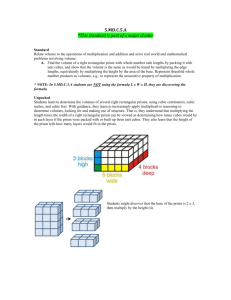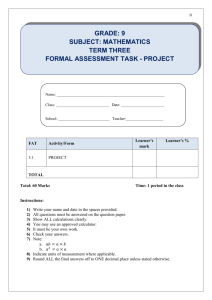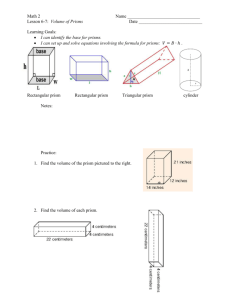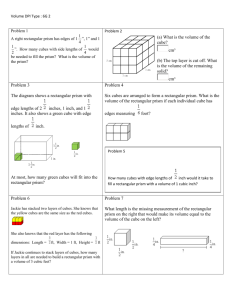Chapter 12 Practice - Surface Area and Volume of Solids
advertisement
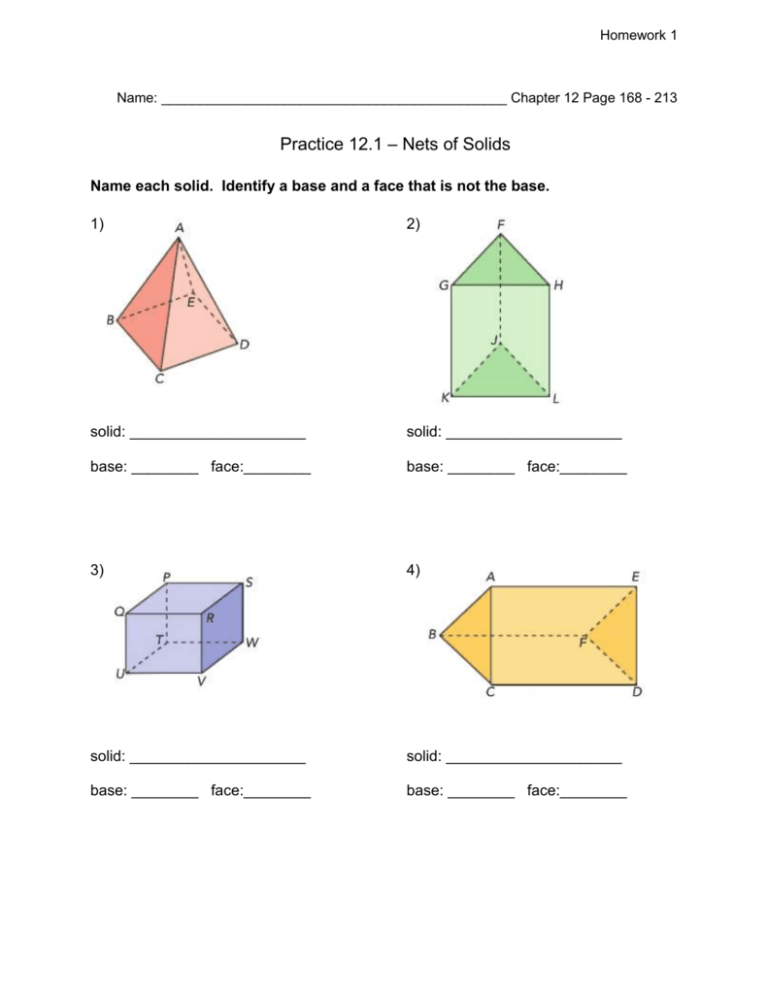
Homework 1 Name: _____________________________________________ Chapter 12 Page 168 - 213 Practice 12.1 – Nets of Solids Name each solid. Identify a base and a face that is not the base. 1) 2) solid: _____________________ solid: _____________________ base: ________ face:________ base: ________ face:________ 3) 4) solid: _____________________ solid: _____________________ base: ________ face:________ base: ________ face:________ Homework 2 Name the solid that each net forms. 5) 6) solid: _____________________ 7) solid: _____________________ solid: _____________________ 8) solid: _____________________ Decide if each net will form a cube. Answer yes or no. 9) 10) Homework 3 Decide if each net will form a cube. Answer yes or no. (Hint: trace on graph paper, cut out, and try to fold into a cube.) 11) 12) 13) 14) 15) Use the graph paper below to draw the 5 other possible nets for a cube. (Do not use the examples used in #9 – 14) Homework 4 Decide if each net will form a prism. Answer yes or no. 16) 17) 18) Using the rectangular prism shown below, label and name the vertices that are not already labeled with the appropriate letter. 19) Homework 5 Practice 12.2 – Surface Area of Solids Solve. Use your formula sheet. Plugin carefully to the appropriate equation. 1) A cube has edges measuring 6 centimeters each. Find the surface area of the cube. 2) The edge length of a cube is 3.5 inches. Find the surface area of the cube. 3) A closed rectangular tank measures 12 meters by 6 meters by 10 meters. Find the surface area of the tank. 4) A closed rectangular tank has a length of 8.5 feet, a width of 3.2 feet, and a height of 4.8 feet. Find the surface area of the tank. Homework 6 Solve. 5) A triangular prism with its measurements is shown. Find the surface area of the prism. 6) A triangular prism with its measurements is shown. Find the surface area of the prism. Homework 7 7) A square pyramid has four faces that are congruent isosceles triangles. Find the surface area of the square pyramid if the base area is 169 square centimeters. 8) The faces of this solid consist of four identical trapezoids and two squares. The side lengths of the two squares are 4 centimeters and 8 centimeters. The height of each trapezoid is 12 centimeters. Find the surface area of the solid. Homework 8 9) Mr. Jones wants to paint the walls of a rectangular room. The height of the room is 8 feet. The floor is 10.5 feet wide and 12 feet long. The doors and windows total 24 square feet and are not going to be painted. Find the total area of the walls that need to be painted. 10) The base of a prism has n sides. Write an expression for each of the following. a) the number of vertices: ____________ b) the number of edges: _____________ c) the number of faces: ______________ 11) The base of a pyramid has m sides. Write an expression for each of the following. a) the number of vertices: ____________ b) the number of edges: _____________ c) the number of faces: ______________ Homework 9 Practice 12.3 – Volume of Prisms Solve. Use your formula sheet. Plugin carefully to the appropriate equation. 1) A cube has edges measuring 9 inches each. Find the volume of the cube. 2) The edge length of a cube is 6.5 centimeters each. Find the volume of the cube. 3) A storage container is shaped like a rectangular prism. The container is 20 feet long, 10 feet wide, and 5 ½ feet high. Find the volume of the storage container. 4) Find the volume of the peppermint tea box below. Homework 10 Solve. 5) The solid below is made of identical cubes. Each cube has an edge length of 2 inches. Find the volume of the solid. Find the volume of the triangular prism. 6) 7) Homework 11 Tell whether slices parallel to each given slice will form uniform cross sections. If not, explain why not. 8) 9) 10) Draw a slice that has the same cross section as the bases in each prism. 11) 12) 13) Solve. 14) The bases of the prism shown are trapezoids. Find the volume of the prism. Homework 12 15) A cube has a volume of 125 cubic inches. Find the length of its edge. 16) The volume of a triangular prism is 400 cubic centimeters. Two of its dimensions are given in the diagram. Find the height of a triangular base. 17) A cross section of the triangular prism shown below is parallel to a base. The area of the cross section is 24 square feet. The ratio of DM to MA is 3 : 5 and the length of 𝐹𝑂 is 6 feet. Find the volume of the triangular prism. Homework 13 18) The volume of the rectangular prism shown below is 2,880 cubic inches. The cross section shown is parallel to a base. The area of the cross section is 180 square inches. The length of 𝐴𝐵 is x inches, and the length of 𝐵𝐶 is 4x inches. a) Find the length of 𝐴𝐶. b) Find the value of x. 19) In the diagram of a cube shown below, points A, B, C, and D are vertices. Each of the other points on the cube is a midpoint of one of its sides. Describe a cross section of the cube that will form each of the following figures. (Use the points to describe.) a) a rectangle: ____________ b) an isosceles triangle: ___________ c) an equilateral triangle: __________ d) a parallelogram: _____________ Homework 14 20) Points A, B, C, and D form a square. The area of the square is 9 square units. a) Find the side length of square ABCD. ________________ b) The coordinates of point A are (2, 6). Points B and C are below 𝐴𝐷 . Point B is below point A, and point D is to the right of point A. Plot the points in a coordinate plane. Connect the points to draw square ABCD. c) The points E, F, G, and H also form a square that is the same size as square ABCD. Point E is 4 units to the right of point A, and 3 units up. Point F and G are below 𝐸𝐻. Point F is below point E, and point H is to the right of point E. Plot the points in the coordinate plane. Draw 𝐸𝐻 and 𝐺𝐻 with solid lines, and 𝐸𝐹 and 𝐹𝐺 with dotted lines. d) Draw 𝐴𝐸 , 𝐷𝐻, and 𝐶𝐺 with solid lines, and 𝐵𝐹 with dashed lines. Use the solid and dashed lines to see the figure as a solid. Name the type of prism formed. e) If the height of the prism is 7 units, find the volume of the prism. Homework 15 Practice 12.4 – Real-World Problems: Surface Area and Volume 1) Savannah has a water bottle that is a rectangular prism. The bottle measures 7 centimeters by 5 centimeters by 18 centimeters and she filled it completely with water. Then, she drank 1 4 of the volume of water in her water bottle. How many cubic centimeters of water were left in the water bottle? 2) A rectangular prims has a square base with edges measuring 8 inches each. Its volume is 768 cubic inches. a) Find the height of the prism. b) Find the surface area of the prism. Homework 16 3) A triangular prism has the measurements shown. a) Find the volume of the prism. b) Find the surface area of the prism. 4) The volume of Box A is 2 5 the volume of Box B. What is the height of Box A if it has a base area of 32 square centimeters? Homework 17 5) The ratio of the length to the width to the height of an open rectangular tank is 10 : 5: 8. The height of the tank is 18 feet longer than the width. a) Find the volume of the tank. b) Find the surface area of the open tank. Homework 18 6) Janice is making a gift box. The gift box is a prism with bases that are regular hexagons, and has the dimensions shown in the diagram. a) Find the height PQ of the prism. b) Find the surface area of the prism. Homework 19 7) Container A was filled with water to the brim. Then some of the water was poured into an empty Container B until the height of the water in both containers became the same. Find the new height of the water in both containers. Homework 20


